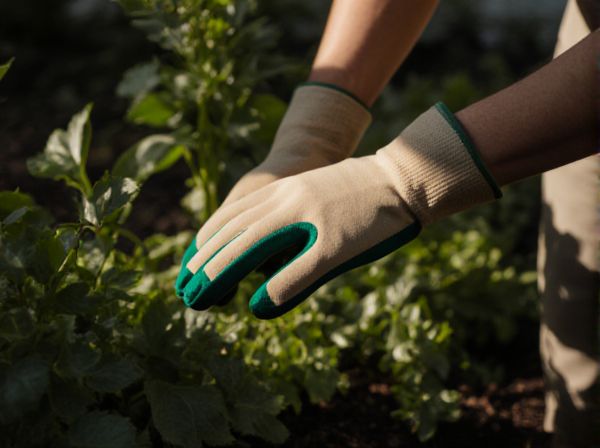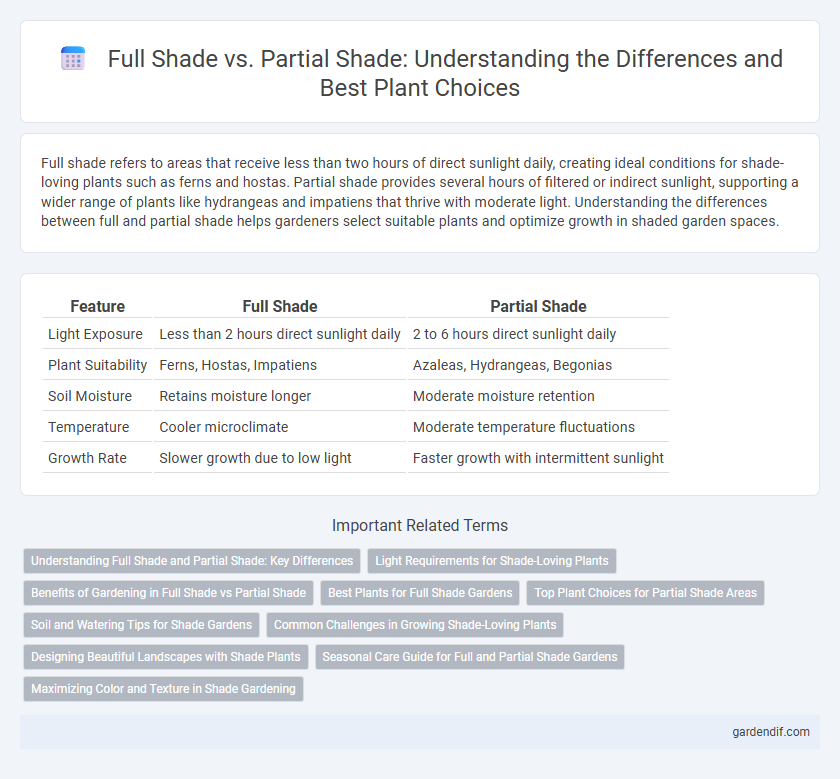
Full Shade vs Partial Shade Illustration
Full shade refers to areas that receive less than two hours of direct sunlight daily, creating ideal conditions for shade-loving plants such as ferns and hostas. Partial shade provides several hours of filtered or indirect sunlight, supporting a wider range of plants like hydrangeas and impatiens that thrive with moderate light. Understanding the differences between full and partial shade helps gardeners select suitable plants and optimize growth in shaded garden spaces.
Table of Comparison
| Feature | Full Shade | Partial Shade |
|---|---|---|
| Light Exposure | Less than 2 hours direct sunlight daily | 2 to 6 hours direct sunlight daily |
| Plant Suitability | Ferns, Hostas, Impatiens | Azaleas, Hydrangeas, Begonias |
| Soil Moisture | Retains moisture longer | Moderate moisture retention |
| Temperature | Cooler microclimate | Moderate temperature fluctuations |
| Growth Rate | Slower growth due to low light | Faster growth with intermittent sunlight |
Understanding Full Shade and Partial Shade: Key Differences
Full shade refers to areas that receive less than two hours of direct sunlight daily, with filtered or reflected light throughout the day, ideal for shade-tolerant plants like ferns and hostas. Partial shade, also known as filtered shade, gets between two to four hours of direct sunlight, often during morning or late afternoon, supporting a wider range of plants such as hydrangeas and impatiens. Understanding these differences is crucial for optimizing plant health and garden design, as light exposure directly affects photosynthesis, growth, and flowering patterns.
Light Requirements for Shade-Loving Plants
Full shade areas receive less than two hours of direct sunlight daily, ideal for shade-loving plants like ferns, hostas, and impatiens that require minimal light to thrive. Partial shade offers three to six hours of filtered or indirect sunlight, suitable for plants such as astilbes, bleeding hearts, and hydrangeas that need moderate light exposure for healthy growth. Understanding the specific light requirements helps ensure optimal photosynthesis and development for each shade-loving species.
Benefits of Gardening in Full Shade vs Partial Shade
Gardening in full shade supports the growth of shade-tolerant plants like ferns and hostas, promoting lush, low-maintenance landscapes that conserve water and reduce heat stress. Partial shade allows for a wider variety of plants, including many flowering species, enhancing biodiversity and seasonal interest while still protecting from harsh midday sun. Both environments improve soil moisture retention and create microclimates that benefit surrounding wildlife and improve garden resilience.
Best Plants for Full Shade Gardens
Full shade gardens receive less than two hours of direct sunlight daily, making them ideal for shade-tolerant plants such as ferns, hostas, and astilbes that thrive in low-light conditions. Partial shade gardens experience three to six hours of dappled or filtered sunlight, supporting a broader range of plants including hydrangeas, coral bells, and impatiens. Selecting the best plants for full shade ensures lush, healthy growth and vibrant foliage in the darkest garden corners.
Top Plant Choices for Partial Shade Areas
Top plant choices for partial shade areas include hostas, astilbes, and ferns, which thrive with filtered sunlight and moderate moisture. Japanese forest grass and bleeding hearts also flourish in these conditions, offering textured foliage and vibrant seasonal blooms. Selecting plants adapted to partial shade ensures healthy growth and vibrant garden aesthetics.
Soil and Watering Tips for Shade Gardens
Soil in full shade gardens should be rich in organic matter to retain moisture and support low-light tolerant plants, while well-drained soil is essential in partial shade to prevent root rot from excess watering. Watering schedules need adjustment; full shade areas typically require less frequent watering due to reduced evaporation, whereas partial shade gardens benefit from more consistent moisture to accommodate higher light exposure. Mulching helps conserve soil moisture and regulate temperature in both shade conditions, promoting healthy root development and plant growth.
Common Challenges in Growing Shade-Loving Plants
Growing shade-loving plants in full shade often results in slowed growth due to insufficient sunlight for photosynthesis, causing leggy or sparse foliage. Partial shade conditions can lead to uneven light exposure, creating stress that promotes pest infestations and fungal diseases like powdery mildew. Managing soil moisture consistently remains a challenge in both environments, as inadequate drainage or excess humidity can stunt root development and reduce plant vitality.
Designing Beautiful Landscapes with Shade Plants
Full shade areas receive less than two hours of direct sunlight daily, ideal for shade-loving plants like hostas, ferns, and hydrangeas that thrive in low-light conditions. Partial shade zones get between two to six hours of filtered or dappled sunlight, perfect for plants such as azaleas, impatiens, and astilbes, which require moderate light to flourish. Designing landscapes by strategically placing full shade and partial shade plants enhances visual contrast, supports plant health, and creates dynamic, lush garden environments.
Seasonal Care Guide for Full and Partial Shade Gardens
Full shade gardens require plants that thrive with less than three hours of direct sunlight daily, necessitating careful seasonal watering adjustments to prevent root rot during rainy seasons. Partial shade gardens benefit from 3 to 6 hours of filtered sunlight, with spring and fall being ideal for fertilizing and mulching to enhance soil nutrition and moisture retention. Seasonal pruning in both full and partial shade gardens promotes healthy growth by removing dead foliage and increasing airflow, reducing the risk of fungal diseases.
Maximizing Color and Texture in Shade Gardening
Maximizing color and texture in shade gardening depends on understanding the difference between full shade and partial shade. Full shade areas receive less than two hours of direct sunlight daily, favoring shade-loving plants such as hostas, ferns, and astilbes that offer rich foliage and varied textures. Partial shade zones, with three to six hours of filtered sunlight, support vibrant flowering plants like impatiens and begonias, enhancing both color intensity and visual texture in shaded landscapes.
Full Shade vs Partial Shade Infographic

 gardendif.com
gardendif.com